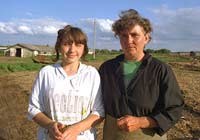
Grades 9-12, College, Adult
Directed by Slawomir Grünberg
Produced by Log In Productions
US Release Date: 1998
Copyright Date: 1997
VHS ISBN: 1-56029-752-2
Subjects
Conflict Resolution
Environment
Geography
Health
Humanities
International Studies
Migration and Refugees
Nuclear Energy
Political Science
Radiation
Russian/Slavic Studies
Social Psychology
Sociology
War and Peace
Awards and Festivals
Grand Prize, Ekofilm, Cesky Krumlov
CINE Golden Eagle
Silver Apple, National Educational Media Network Competition
Bronze Plaque, Columbus International Film & Video Festival
Prize of Independent Economic Forum, EKOTOPFILM, Slovakia
Honorable Mention, EarthVision Env'l Film & Video Competition
American Public Health Association Film Festival
Ecofilm (Les cahiers du future), Paris
Fleeing the war in Chechnya, refugees have settled near Chernobyl.
 |
"Grunberg does a skillful job of portraying the bleak choices that the people of the former Soviet Union face. " |
In recent years, hundreds of thousands of refugees have fled wars and political turmoil in Chechnya, Tajikistan, Georgia and Azerbaijan in order to find peace in the radioactive pastures surrounding Chernobyl, scene of the world's worst nuclear accident in 1986.
"I prefer living with radiation over living in a war zone," says one former resident of Chechnya.
The tiny, little-known country of Belarus has suffered more than any other in the aftermath of the Chernobyl disaster. Winds scattered the heaviest radioactive deposits across the country, where after a decade 25% of the land is still judged uninhabitable. Thousands of villages and towns were abandoned or evacuated, and their populations resettled to safer areas.
When Russian-speaking filmmaker Slawomir Grünberg heard that local governments were encouraging people to resettle the irradiated villages, he decided to go there with his camera. His film documents the latest twist in the Chernobyl disaster and the evolution of the former Soviet republics.
In the village of Raduga he met the Tsiplaevs, an ethnic Russian family from Grozny, the capital of Chechnya. Like many, they've chosen to risk their health, and the health of their children's children, in exchange for a life without the constant fears of living in a war zone.
In recent years, hundreds of thousands of refugees have fled wars and political turmoil in Chechnya, Tajikistan, Georgia, and Azerbaijan in order to find peace in the radioactive pastures surrounding Chernobyl, scene of the world's worst nuclear accident in 1986.
"I prefer living with radiation over living in a war zone," says one former resident of Chechnya.
The tiny, little-known country of Belarus has suffered more than any other in the aftermath of the Chernobyl disaster. Winds scattered the heaviest radioactive deposits across the country, where after a decade 25% of the land is still judged uninhabitable. Thousands of villages and towns were abandoned or evacuated, and their populations resettled to safer areas.
When Russian-speaking filmmaker Slawomir Grunberg heard that local governments were encouraging people to resettle the irradiated villages, he decided to go there with his camera. His film documents the latest twist in the Chernobyl disaster and the evolution of the former Soviet republics.
In the village of Raduga, he met the Tsiplaevs, an ethnic Russian family from Grozny, the capital of Chechnya. Like many, they've chosen to risk their health, and the health of their children's children, in exchange for a life without the constant fears of living in a war zone.
Reviews
"A unique film that covers a topic of which most of us are unaware. This intriguing documentary is recommended for an undergraduate college curriculum that would cover modern European history or current events."